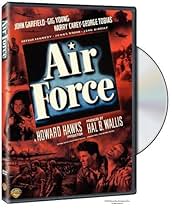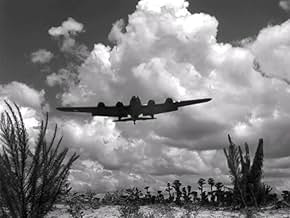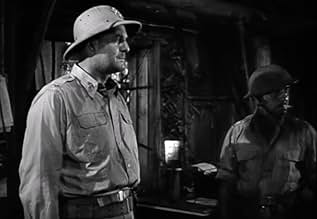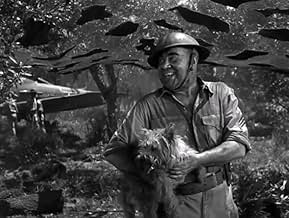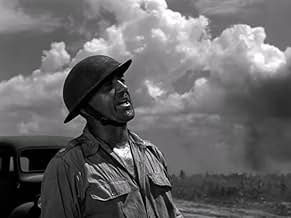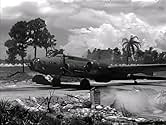Adicionar um enredo no seu idiomaThe crew of an Air Force bomber arrives in Pearl Harbor in the aftermath of the Japanese attack on December 7, 1941, and is sent on to Manila to help with the defense of the Philippines.The crew of an Air Force bomber arrives in Pearl Harbor in the aftermath of the Japanese attack on December 7, 1941, and is sent on to Manila to help with the defense of the Philippines.The crew of an Air Force bomber arrives in Pearl Harbor in the aftermath of the Japanese attack on December 7, 1941, and is sent on to Manila to help with the defense of the Philippines.
- Direção
- Roteiristas
- Artistas
- Ganhou 1 Oscar
- 3 vitórias e 3 indicações no total
- Marine Sgt. J.J. Callahan
- (as Edward S. Brophy)
Avaliações em destaque
The plane leaves 12/6/41 for Hickam Field in Hawaii and we know what happened the next day. The Mary Ann lands and takes off and makes a bunch of stops where the Japanese are attacking. In the end they are part of a nasty battle.
Warner Brothers special effects was at the top of its game. The cast is perfectly suited for their roles right down to a dog that gets hostile at the name Moto. Captain John Ridgely's death scene is the dramatic highlight of the film.
Air Force got an Oscar for film editing. It's a wartime flag waver to be sure but it still holds up well today.
Você sabia?
- CuriosidadesBecause of the constant noise in the planes, air crews wore "throat mics." These had two pickups that sat against the larynx (vocal cords) and picked the sound up directly from them. You will notice that whenever a crew member speaks he puts his hand up against the mic and presses it against his throat. This helped ensure good sound pickup.
- Erros de gravaçãoUnseen "snipers" attack the "Mary Ann" while at Maui. No Japanese "snipers" landed anywhere in the Hawaiian Islands during the attack.
- Citações
Radio Operator Peterson: [looking down] That's an awful big town, San Francisco.
Assistant Crew Chief Weinberg: Strictly a one whistle stop. There's only one city in the U.S.A. and that's New York.
Sgt. Robbie White: Oh, you're just a hometown hick, Weinberg. What's wrong with California?
Assistant Crew Chief Weinberg: California? The sun shines and nuthin' ever happens. Before you know it, you're 60 years old.
Sgt. Robbie White: It's no different from New York. My sister's been tryin' to get out of Brooklyn for the last 40 years.
Assistant Crew Chief Weinberg: Brooklyn? That ain't New York, chief. Once you cross that Brooklyn Bridge, you're outta this woild. The only noise you hear is the hardening of your arteries. You know when I used to drive a hack, I had a pal who crossed that bridge in 1929. Ain't ever heard from him since.
Radio Operator Peterson: Me, I'll take Minneapolis.
Assistant Crew Chief Weinberg: Minneapolis? Why, the grass still grows in the streets. Besides, that ain't your hometown, Peterson. The hayseed's still stickin' outta your hair.
Radio Operator Peterson: Yeah, but I can still milk a cow. I bet you can't.
Assistant Crew Chief Weinberg: I'll get mine outta a bottle. That's the closest I ever wanna be to a cow.
Sgt. Robbie White: You are handy with the old bull.
Assistant Crew Chief Weinberg: [laughs]
- Cenas durante ou pós-créditosOpening credits prologue: FOREWORD "It is for us the living .... to be dedicated here to the unfinished work which they who fought here have thus far so nobly advanced ..... It is ......for us to be here dedicated to the great task remaining before us ..... that this nation, under God, shall have a new birth of freedom and that government of the people, by the people, for the people, shall not perish from the earth." Abraham Lincoln
- ConexõesEdited into War and Remembrance: Part IV (1988)
- Trilhas sonorasThe Army Air Corps Song
(1939) (uncredited)
("Off We Go Into the Wild Blue Yonder")
Written by Robert Crawford
Played during the opening credits and often throughout the film
Principais escolhas
- How long is Air Force?Fornecido pela Alexa
Detalhes
- Data de lançamento
- País de origem
- Central de atendimento oficial
- Idiomas
- Também conhecido como
- Los que supieron morir
- Locações de filme
- Empresa de produção
- Consulte mais créditos da empresa na IMDbPro
Bilheteria
- Orçamento
- US$ 2.646.000 (estimativa)
- Tempo de duração
- 2 h 4 min(124 min)
- Cor
- Proporção
- 1.37 : 1


